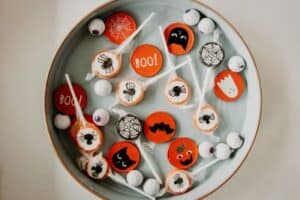
27 Oct Preventing Cavities: What Parents Should Know During Halloween
Preventing Cavities: What Parents Should Know During Halloween
Halloween is a time for spooky costumes, exciting adventures, and, of course, candy. While it’s thrilling for kids to collect a mountain of treats, the sugar rush also comes with a downside—an increased risk of cavities. For parents, this presents a balancing act: how to let kids enjoy Halloween while protecting their dental health. Here’s a complete guide on what you should know to prevent cavities during Halloween.
Introduction to Halloween and Dental Health Risks
Halloween is one of the most anticipated nights for children, filled with candy, chocolates, and treats. But with all the sugary excitement, there’s also an increase in dental health risks. Sugary snacks, especially sticky or hard candies, create the perfect environment for cavity-causing bacteria. Understanding these risks and how sugar affects your child’s teeth can help parents make better choices.
Why Excessive Sugar Leads to Cavities
Cavities form when bacteria in the mouth feed on sugars, producing acid that gradually erodes tooth enamel. This process, called demineralization, is worsened with frequent exposure to sugar, especially when kids snack on candy throughout the day. Limiting sugar intake and ensuring a balanced diet can help prevent cavities.

Types of Halloween Candies and Their Effects on Teeth
Not all candies affect teeth the same way. Here’s how different types impact dental health:
- Sticky Candies (Caramels, Gummies): These tend to cling to teeth and are harder to wash away with saliva.
- Hard Candies (Lollipops, Jolly Ranchers): Hard candies expose teeth to sugar for extended periods and can crack teeth if bitten.
- Sour Candies: The high acidity of sour candies can weaken enamel, making teeth more prone to cavities.
- Chocolate: Compared to other treats, chocolate is easily washed away by saliva, making it a relatively better choice for Halloween.
By choosing chocolates over sticky or hard candies, parents can make Halloween a little more tooth-friendly.
Recognizing Cavity-Prone Foods Beyond Candy
Cavities aren’t only caused by candy. Other foods and drinks popular at Halloween, like sugary sodas, juices, and starchy snacks, also increase the risk. Encouraging kids to limit these items can help keep cavities at bay.
Importance of Setting Boundaries on Halloween Treats
While it’s unrealistic to keep kids from enjoying any treats, setting boundaries can prevent overindulgence. Portioning candy, mixing it with other healthy snacks, and setting time limits for candy-eating can help manage sugar intake and reduce dental health risks.
Establishing a Dental Routine During Halloween
Maintaining a good oral care routine is crucial during Halloween. Encourage your child to brush twice a day with fluoride toothpaste and floss daily, paying extra attention to brushing after candy consumption. This routine will help reduce plaque buildup and protect against cavities.
Smart Strategies for Halloween Candy Consumption
- Choose Lower-Sugar Options: Opt for treats with lower sugar content when possible.
- Limit Sticky Candies: Avoid gummy bears, caramel, and taffy, which stick to teeth and are harder to clean off.
- Encourage Drinking Water: Water helps rinse away sugar and bacteria after candy consumption.
By selecting healthier options and practicing good habits, kids can enjoy Halloween with less risk to their teeth.
Fun and Healthy Treat Alternatives for Halloween
Consider these non-sugar treats to celebrate Halloween without compromising dental health:
- Fruit cups or sliced apples
- Mini cheese or nut packs
- Sugar-free gum or mints
- Fun Halloween stickers or small toys
Introducing a few of these options to the treat bowl can show kids that healthy can be fun.

Educating Kids About Dental Health in a Fun Way
Halloween provides a perfect opportunity to educate children about the importance of dental health. Try these activities:
- Dental-Themed Storybooks: Read books that encourage good dental habits.
- Brushing Games: Use fun songs or apps to encourage brushing after enjoying treats.
- “Monster Teeth” Demonstrations: Use cartoon characters to explain how cavities form, making it relatable and engaging.
Teaching kids about dental health in a fun way ensures that they remember these lessons long after Halloween.
Balancing Treats and Healthy Habits for Overall Wellness
Maintaining a healthy balance during Halloween goes beyond avoiding cavities. Parents can help kids balance treats with healthy snacks, staying hydrated, and staying active to enjoy the holiday in a healthy way.
Signs Your Child Might Have a Cavity
Be aware of these signs after Halloween:
- Tooth sensitivity or pain: This can indicate early stages of tooth decay.
- Visible pits or holes: Sometimes, cavities can be seen as dark or light spots on the teeth.
- Bad breath: Persistent bad breath can be a sign of cavities or plaque buildup.
If your child shows any of these symptoms, schedule a dentist appointment to address potential issues before they worsen.
Scheduling a Post-Halloween Dental Check-Up
A post-Halloween dental check-up can catch early signs of cavities or other dental issues. Many family dental practices offer affordable check-ups or preventive services, which are especially valuable following Halloween’s sugary festivities.

FAQs on Halloween and Dental Health
How much candy is too much?
A small treat or two per day, ideally after a meal, helps minimize cavity risks by reducing continuous sugar exposure. Eating candy after meals also takes advantage of increased saliva production, which helps wash away sugar. Designating a specific treat time can prevent kids from grazing on sweets all day.
Are sour candies worse than other candies?
Yes, sour candies are highly acidic, which weakens tooth enamel and makes teeth more vulnerable to decay. These candies often stick to teeth or dissolve slowly, increasing sugar exposure and potential damage. Rinsing with water afterward can help neutralize acids until it’s time to brush.
What if my child doesn’t like brushing their teeth?
Try flavored toothpaste or a fun toothbrush with their favorite characters, or make brushing fun with a game or app. Brushing together can also make it feel like a shared activity instead of a chore. Positive reinforcement, like reward charts, encourages good brushing habits and consistency.
Is chocolate really better than other candies?
Chocolate, especially plain or dark varieties, doesn’t stick to teeth and dissolves more quickly than sticky or hard candies. It’s also easier for saliva to wash away, which reduces sugar exposure. Dark chocolate with lower sugar content is even better for dental health.
Can sugar-free candy still cause cavities?
Sugar-free candy usually doesn’t cause cavities because it lacks the sugars that bacteria feed on, though some types are still acidic. Sugar-free options with xylitol may help reduce cavity risk by inhibiting bacterial growth. It’s still essential to brush regularly, as acids from even sugar-free candy can impact enamel.
What are some healthy treat alternatives for Halloween?
Healthy Halloween treats like sliced apples, nuts, and popcorn provide natural sweetness and crunch without the sugar. Non-food treats, like stickers and glow sticks, are also fun options kids enjoy. By offering a mix of alternatives, you can keep Halloween exciting without excess sugar.
How soon after eating candy should my child brush their teeth?
It’s best to wait about 30 minutes after eating candy before brushing, as this allows saliva to neutralize acids and protect enamel. Brushing immediately can wear down softened enamel from acidic candies. Meanwhile, encourage your child to drink water to help wash away sugar and acids.
What’s the best way to store Halloween candy to prevent overindulgence?
Store Halloween candy out of sight in a designated spot and portion out treats for specific times, such as after meals. Keeping candy in a sealed container can make it feel more controlled and less accessible for constant snacking. This helps kids enjoy treats mindfully without overindulging.
Should my child chew gum after eating candy?
Yes, chewing sugar-free gum after candy can be beneficial, as it increases saliva flow, which helps wash away sugar and neutralize acids. Look for gum with xylitol, a sweetener that can reduce cavity-causing bacteria. Just ensure it’s sugar-free, as regular gum could add more sugar exposure.
Conclusion: Enjoying a Safe Halloween with a Healthy Smile
Halloween can be enjoyed with minimal impact on dental health by practicing moderation, educating kids, and sticking to good habits. These practices not only prevent cavities but also teach kids the value of dental care for a bright, healthy smile throughout the year.


Sorry, the comment form is closed at this time.